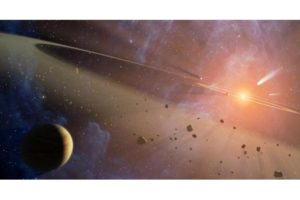From pebble to planet: Researchers find humble beginnings of gas giants.
Massive planets like Jupiter and Saturn may have started as tiny pebbles, according to planetary scientists at the Southwest Research Institute in Boulder, Colo.

An artist's conception of a very young planetary system. One model of planet generation posits that orbiting pebbles were the key to forming gas giants.
JPL-Caltech/NASA
New research suggests that massive planets like Saturn and Jupiter started out with just a few small building blocks – more accurately building rocks – just half an inch or so across.
In the spinning, swirling brew of the early solar system, surrounded by bits of dust and ice, small particles of rock melted down to form the early molten cores of these gas giants, according to research featured online Wednesday by the journal Nature. This contradicts previous research that suggested enormous chunks of rock, more than three city blocks long, were needed to form giant planets.
The process described by the research, dubbed “pebble-accretion,” celebrates the role of the little guy.
Early primordial planets sparred while in orbit, knocking and nudging each other using their gravitational fields, say the researchers. Some of the smaller protoplanets got bumped out of the plane of the dusty disk, leaving their bigger brethren to gobble up the remaining particles of matter and grow larger and larger.
“It’s kind of a runt of the litter thing,” lead author Harold Levison, a planetary scientist at the Southwest Research Institute in Boulder, Colo., told Nature. “The runt is pushed aside by its bigger siblings so that they grow, and it doesn’t.”
Earlier research suggested a less combative form of planetary formation, where particles combined to form large, town-sized celestial chunks which then fused together until they were big enough to hold their own gaseous cloak.
The problem? This process took too long to fit the timetable of the early solar system. Researchers looked at alternative theories, finally hitting on pebble-accretion, which could form large planets 1000 times faster than the other process.
"Some stories of planet formation are 'avoidable' – that is, there are alternative stories – but the pebble-accretion story is in some form or other likely to be important," David Stevenson, a planetary scientist at the California Institute of Technology in Pasadena, who was uninvolved in the study, told Space.com.
Pebble-accretion was first theorized in 2012, but that model had its own issues. When run through a simulator, the process created hundreds of Earth-sized objects in orbit, and no gas giants.
What Dr. Levison and his team did in their model was give more time for the planets to mature and act out in their adolescent years, a technique known to earthling parents since time immemorial.
“We’re doing simulations that actually allow the growing planetesimals to interact and collide with each other,” co-author Katherine Kretke, an astronomer at the Southwest Research Institute, told Nature.
Tweaking the starting conditions on their planetary recipe, the team generally cooked up between one and four giant gas-cloaked planets, similar to Jupiter, Saturn, Uranus, and Neptune.
The positions of the planets aligned nicely with the widely accepted Nice Model, which takes into account how gas giants interact with each other.
“Things are falling together in a way that haven’t happened for previous models,” said Dr. Kretke.
Moving forward, the researchers will use the pebble-accretion theory on other solar systems, to see whether they can explain the existence of those planetary arrangements. In addition, they will keep working to see whether the new theory explains how the terrestrial planets (including Earth) formed. The team is excited to push the limits of their new theory.
“It really is a paradigm shift for how planets form,” said Levison.

